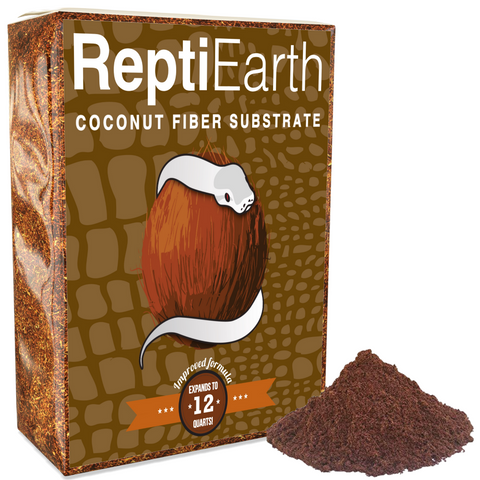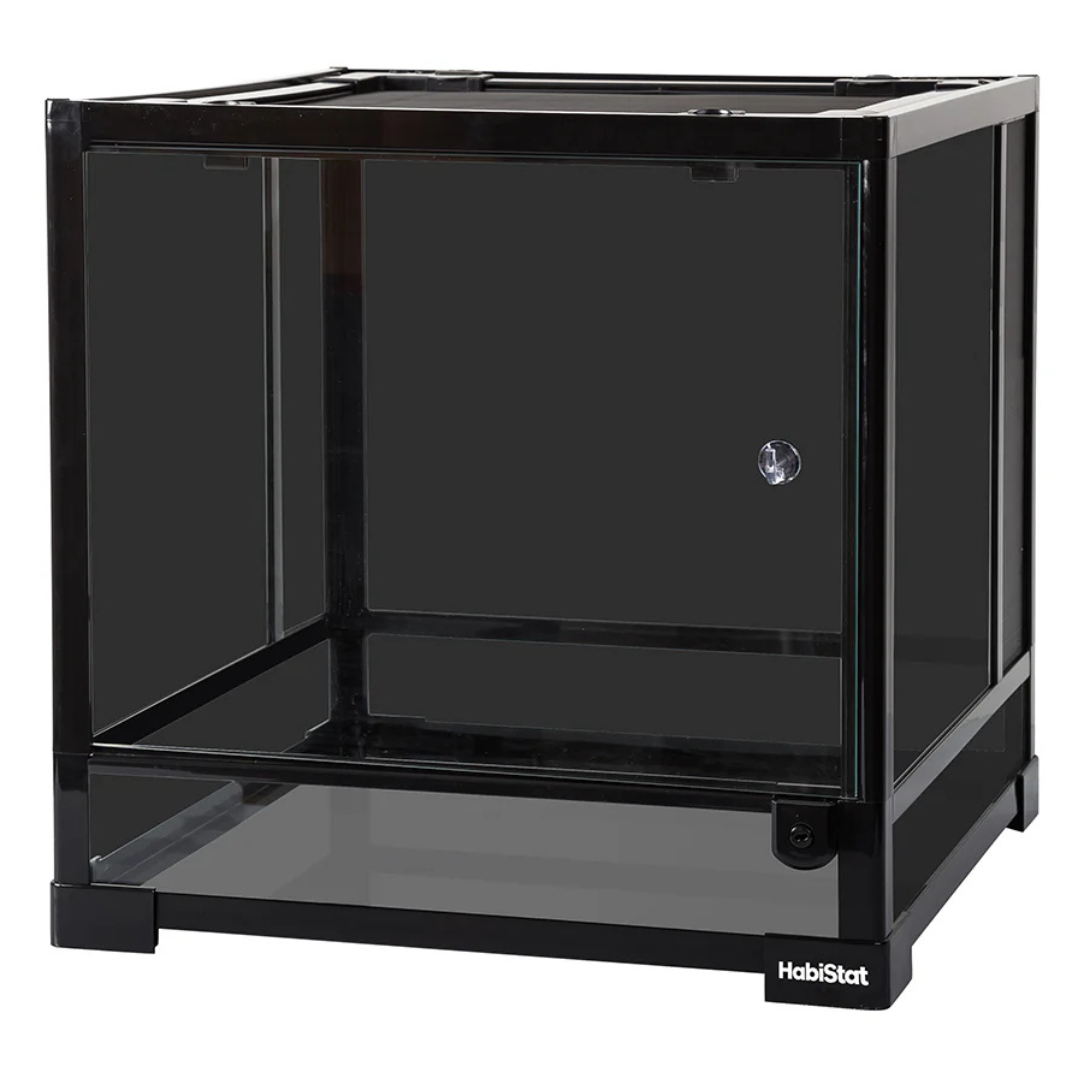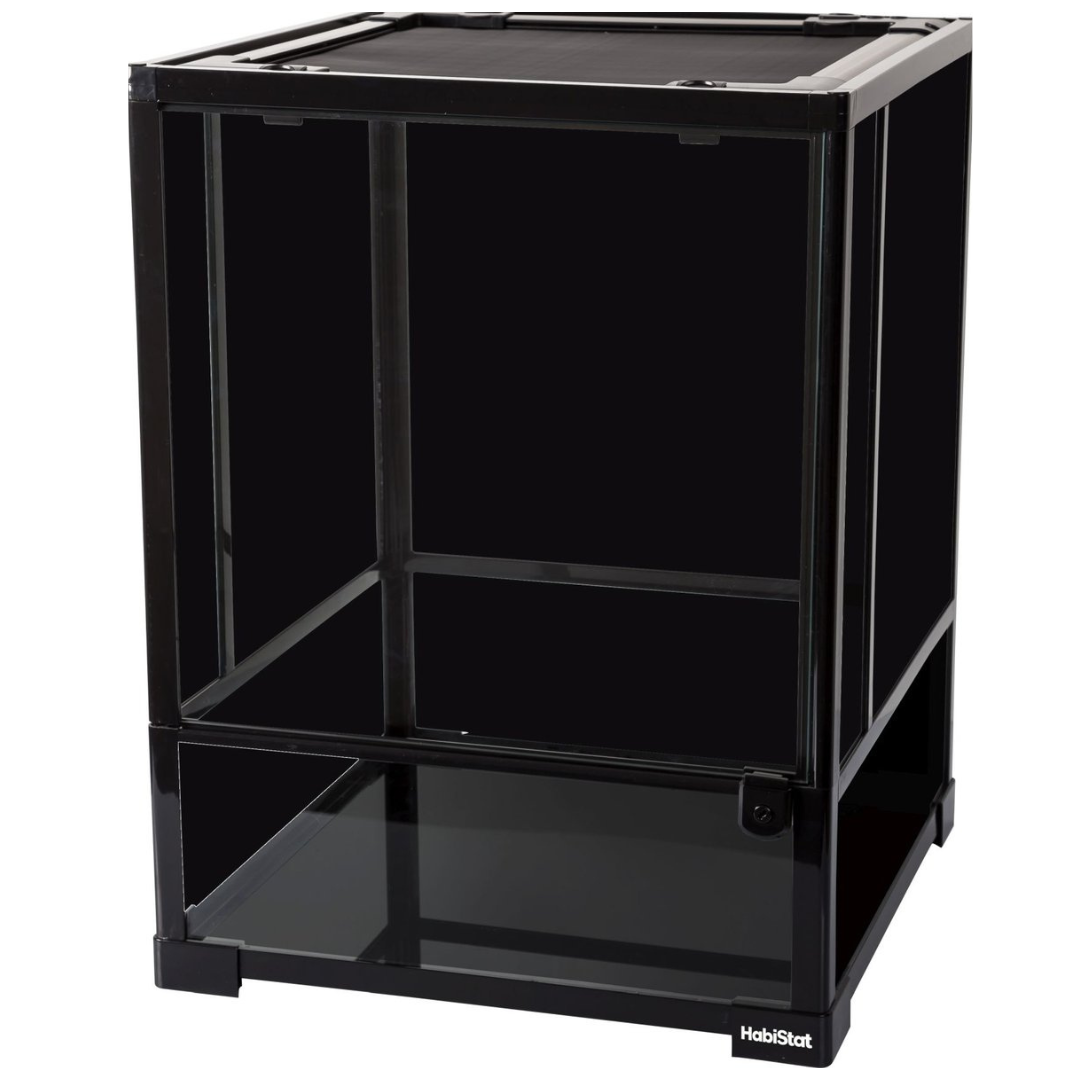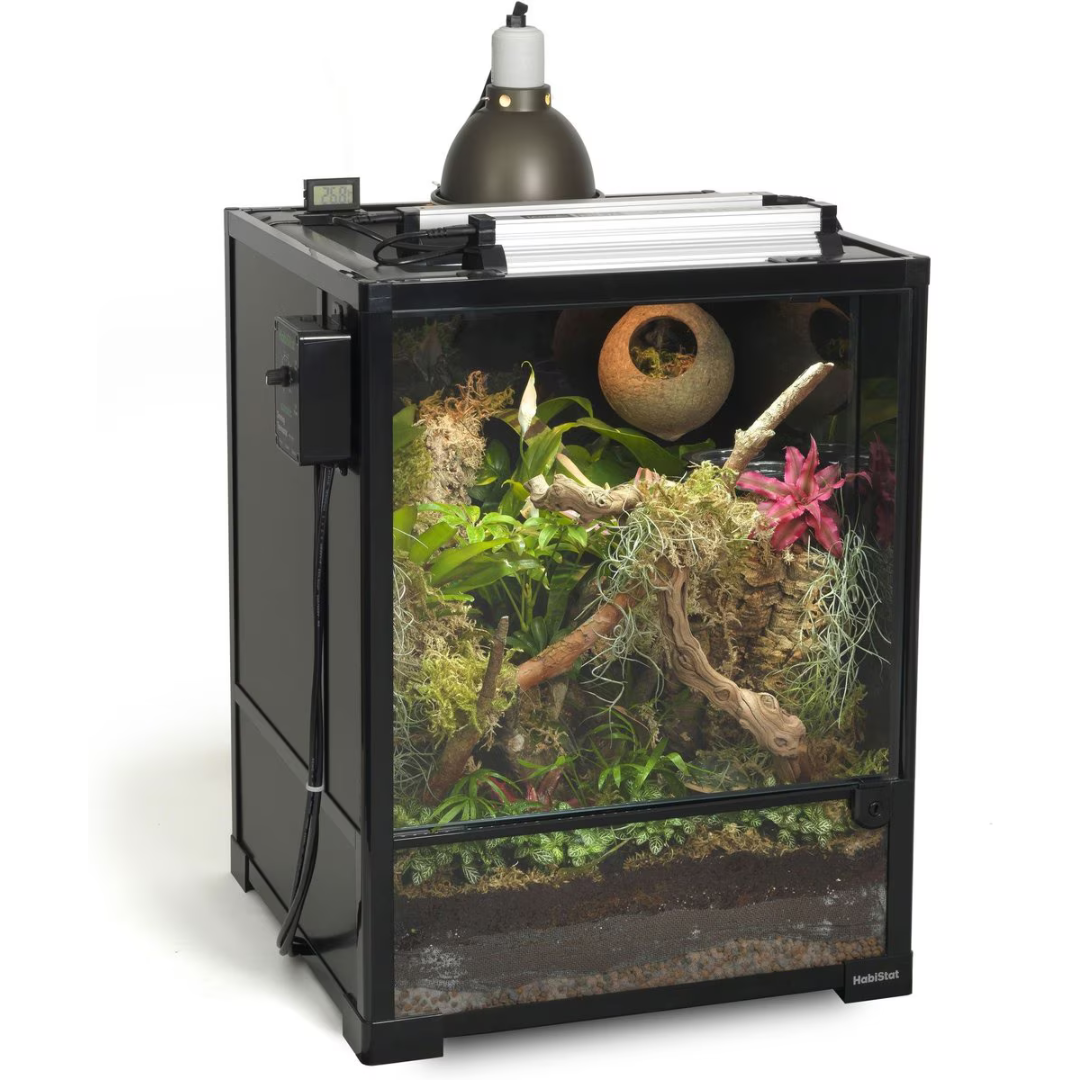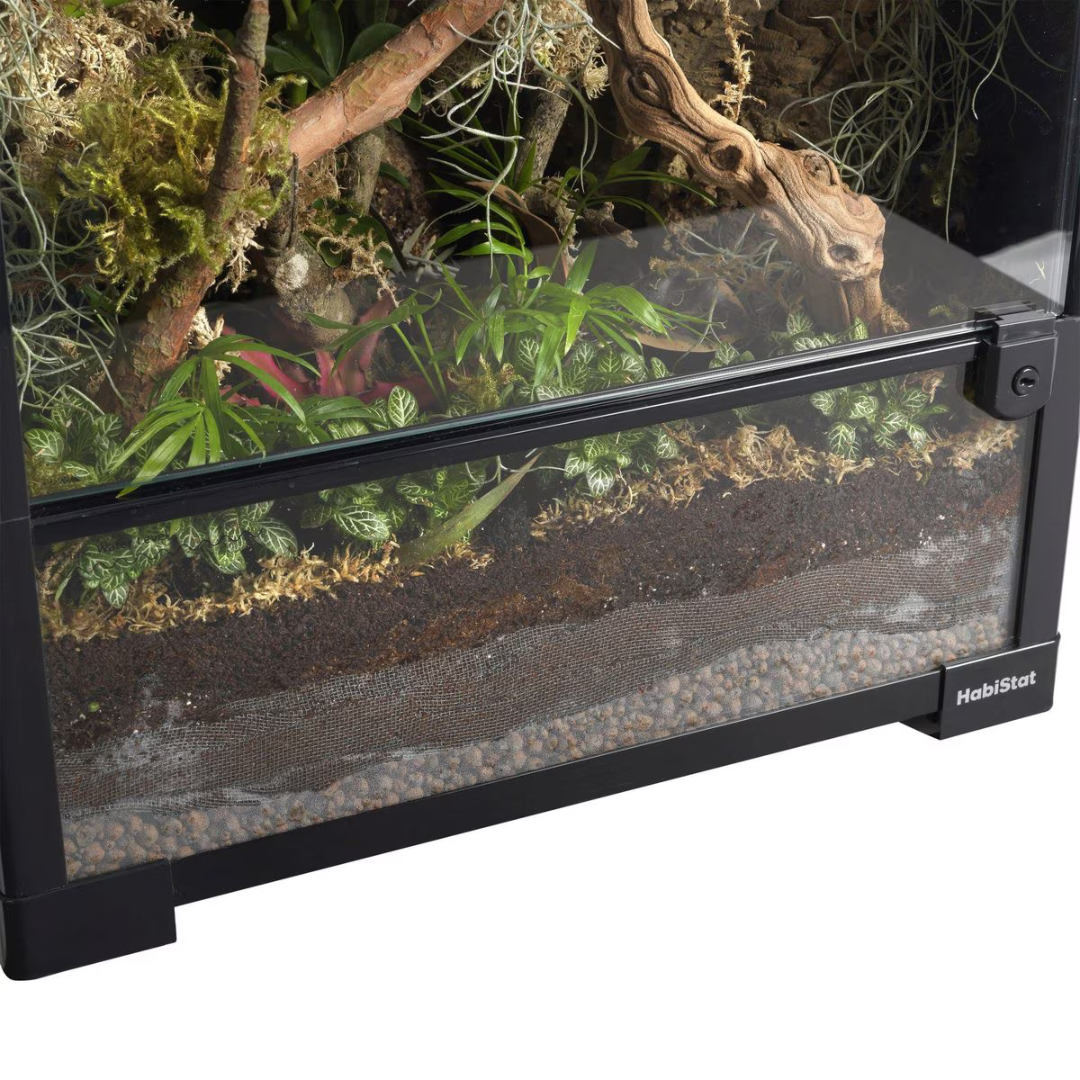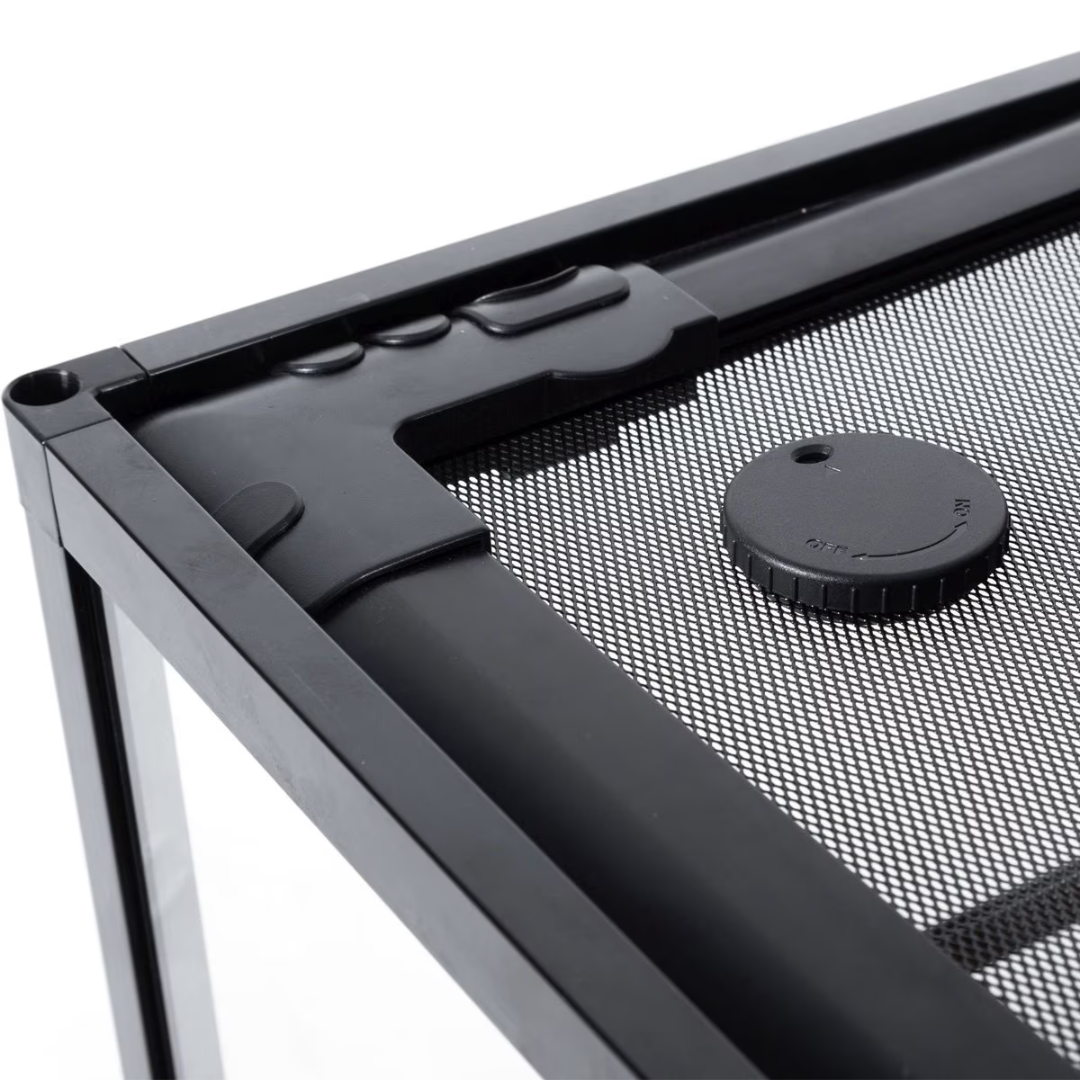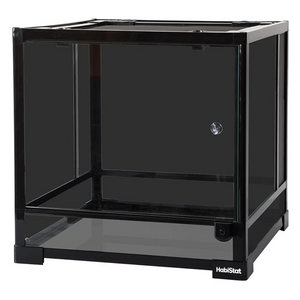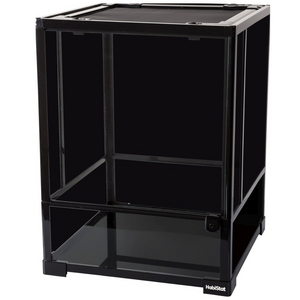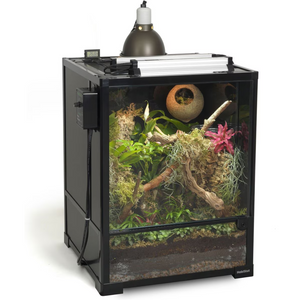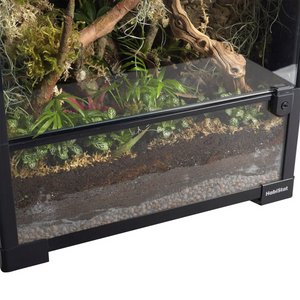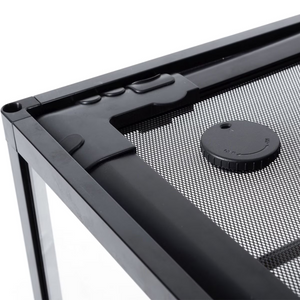Natural History
The fringed leaf frog is a highly specialized tree-dwelling amphibian found in the lowland and foothill rainforests of Central and northern South America. This frog undergoes a complete metamorphosis, beginning life as an aquatic tadpole before transforming into a terrestrial adult. After mating, females select leaves overhanging permanent or slow-moving bodies of water—streams, ponds, or flood pools—on which to lay their clutches. Clutch sizes can range from 20 to 40 eggs, depending on the female’s size and health. The eggs are deposited in gelatinous clusters and left adhered to the underside of a leaf, where they undergo an incubation period of approximately 10 to 14 days. Once hatched, the tadpoles drop into the water below. Development from tadpole to juvenile frog can take between 8 to 12 weeks, during which the larvae undergo radical morphological change, including the resorption of gills and tail. Juveniles grow rapidly in their first year, reaching sexual maturity around 18 to 24 months. Captive frogs can live over 10 years with proper care, though lifespans in the wild are somewhat shorter due to predation and environmental challenges.
Fringed leaf frogs are nocturnal and solitary by nature, becoming active primarily at night when humidity is high and temperatures are cooler. During the day, they remain motionless on the undersides of leaves, relying on their leaf-like appearance for camouflage. Their bodies are adapted for an arboreal lifestyle: long limbs with extensive webbing facilitate efficient leaping and gliding through the canopy, while specialized toe pads aid in climbing. These frogs are ambush predators, feeding primarily on flying and crawling insects such as moths, crickets, beetles, and sometimes smaller frogs or other invertebrates. They use a sit-and-wait strategy, remaining still until potential prey comes within range before lunging and capturing it with a rapid flick of the tongue. Males produce calls during the breeding season to attract females, typically voiced from vegetation near water sources. Territoriality is limited, with calling sites sometimes defended during peak mating periods. Their primary defense mechanism is camouflage, though they may also display sudden flashes of color to startle predators or produce low-intensity distress calls when handled.
In the wild, the fringed leaf frog plays a vital role in maintaining ecological balance. As mid-level predators, they help regulate insect populations, contributing significantly to natural pest control. This is particularly important in tropical ecosystems where insect biomass can be substantial. In turn, they serve as prey for a variety of larger organisms, including snakes, birds, and small mammals such as opossums. Their eggs and tadpoles are vulnerable to aquatic predators, including fish and invertebrate larvae. This species exhibits several environmental adaptations suited to the canopy environment, including cryptic coloration, skin textures that mimic leaf margins, and arboreal egg-laying behaviors that reduce aquatic predation risk. Because of their sensitivity to environmental changes—particularly to moisture levels and water quality—fringed leaf frogs are also considered indicators of ecosystem health. As such, they make important contributions not only to their immediate forest communities but also to broader biodiversity conservation efforts.
Understanding the natural history of the fringed leaf frog is essential for providing informed care in captivity. Their complex life cycle, specialized behaviors, and ecological significance underscore the importance of replicating their native environment as closely as possible when managed under human care.
Conservation Status
The fringed leaf frog is currently classified as "Least Concern" on the IUCN Red List. This status indicates that, at a global level, the species is not facing an immediate risk of extinction. Populations are considered relatively stable, and the species maintains a broad geographic distribution across its native range in the lowland and montane rainforests of Central and South America, particularly within countries such as Colombia, Ecuador, and Peru. The "Least Concern" classification reflects a combination of factors, including the frog's adaptability to certain modified habitats and its persistence in several protected areas. However, this status does not imply that the species faces no threats; rather, it signifies that the current rate of decline and the size and extent of the population do not yet meet the criteria for a more threatened category.
Despite its favorable conservation status, the fringed leaf frog is increasingly impacted by several anthropogenic threats. Habitat destruction remains the most significant challenge, particularly due to deforestation for agriculture, logging, and human settlement. The species relies on arboreal rainforest environments with high humidity, and large-scale canopy loss disrupts critical breeding, sheltering, and foraging behaviors. Additionally, climate change is expected to alter rainfall patterns and temperature regimes in the region, potentially leading to shifts in breeding cycles and the availability of suitable microhabitats. Another prominent threat is the spread of the chytrid fungus (Batrachochytrium dendrobatidis), a disease responsible for global amphibian declines. Although the fringed leaf frog has shown some resilience compared to other amphibian species, its susceptibility in certain regions remains a concern and an active subject of research.
Conservation efforts for the fringed leaf frog are largely centered around habitat preservation and disease monitoring. Many populations reside within well-managed national parks and conservation areas, such as those in the upper Amazon basin, where logging and agriculture are restricted. These protected habitats serve as vital refuges for the species and contribute significantly to long-term population stability. International trade in individuals of this species is regulated under CITES Appendix II, which requires export permits and ensures trade does not harm wild populations. Furthermore, research organizations and local conservation groups are engaged in field studies to monitor population trends and assess disease vulnerability, especially in high-elevation montane forests where chytrid outbreaks have been observed.
Captive breeding initiatives, although limited in this species due to its specialized husbandry requirements, have been launched by select zoological institutions aiming to preserve genetic diversity and better understand the species’ reproductive biology. These programs provide a safety net in the case of severe population crashes in the wild and also generate valuable data that improve in-situ management strategies. In some cases, these ex-situ populations serve as ambassadors for amphibian conservation, helping raise awareness about threats to rainforest ecosystems. Overall, while the fringed leaf frog is not currently at high risk of extinction, continued conservation vigilance is necessary to mitigate emerging threats, particularly those associated with environmental change and pathogen spread. Responsible husbandry and support for conservation education are important ways in which the herpetological community can contribute to the species’ long-term survival.
Native Range
The fringed leaf frog is native to the northern regions of South America, with its distribution primarily concentrated in the upper Amazon Basin. Its range includes portions of southern Colombia, Ecuador, northern and eastern Peru, and western Brazil. While it is not the most widespread amphibian species in the region, it does have a moderately broad distribution within these countries, particularly in areas where undisturbed lowland rainforest habitat remains intact. The species favors primary rainforest ecosystems and is typically absent from areas that have undergone significant deforestation or habitat degradation.
Within its range, the fringed leaf frog inhabits tropical humid forests, which serve as its macrohabitat. These rainforests are characterized by dense tree canopies, high biodiversity, and consistently high moisture levels. The species is arboreal and strictly nocturnal, residing predominantly in the forest canopy during the day and becoming active at night. It shows a strong preference for microhabitats such as broad-leafed branches and shrubs located near slow-moving bodies of water like forest streams, oxbow lakes, and floodplains. These microhabitats provide both camouflage and humidity, which are critical for its survival. During the rainy season, the species can also be found near temporary pools formed by accumulated rainfall, which are used for breeding.
Climatically, the fringed leaf frog relies on a warm, equatorial environment. Daytime temperatures in its natural habitat range from 75°F to 86°F, while nighttime temperatures rarely drop below 68°F. Relative humidity stays consistently high throughout the year, typically between 80% and 100%. Precipitation is abundant, usually exceeding 100 inches annually, and is distributed throughout the year with a pronounced wet season occurring from November to May. This rainy season is essential for triggering breeding activity, as the species requires still or slow-moving water to lay its eggs. In the drier months, the frog may retreat into higher canopy levels or increase inactivity to conserve moisture.
The species is most commonly found at low to mid-elevations, generally ranging from sea level up to about 3,300 feet. It shows a clear preference for elevation zones that maintain high humidity and avoid temperature extremes. At lower elevations, the frog benefits from the consistently warm and humid microclimate created by dense vegetation, a closed canopy, and frequent rainfall. In cloud forests or higher elevation zones, its presence diminishes due to lower temperatures and altered forest structure.
Key environmental factors crucial to the fringed leaf frog's survival include access to shallow aquatic breeding sites, dense overhead canopy providing shade and moisture retention, and a diverse understory offering both food resources and concealment. Its dependence on intact, primary forest means that it is particularly sensitive to logging and habitat fragmentation. Leaf surfaces and dense foliage are especially important, not only for concealment from predators but also for regulating skin moisture through cutaneous respiration. While this frog can tolerate some variation in its environment, long-term survival is contingent on the preservation of stable, undisturbed rainforest ecosystems with plentiful water sources and consistent microclimatic conditions.
Behavior
The fringed leaf frog is a nocturnal arboreal amphibian, meaning it is primarily active at night and spends the majority of its life in trees. In its natural range within the humid tropical forests of Central and northern South America, it becomes active shortly after sundown, often emerging from its daytime refuges among broad leaves and tree hollows to forage, seek mates, and explore its environment. Its nocturnal lifestyle helps it avoid daytime predators and excessive heat while taking advantage of the increased humidity during nighttime.
Seasonal behavioral changes are primarily influenced by rainfall and temperature. During the wet season, which coincides with its breeding season, activity increases significantly, especially among males, which call frequently from vegetation overhanging bodies of water. These calls are used both to attract females and to assert territorial presence to rival males. In the dry season or periods of lower humidity, activity decreases, and the frogs may enter a state of dormancy or reduced activity to conserve moisture, though they do not undergo a true brumation period like some more temperate amphibians.
Fringed leaf frogs are generally solitary outside of the breeding season. Males are territorial when calling and will sometimes engage in physical encounters with rival males, involving wrestling or attempting to displace one another from favored calling sites. These dominance interactions are usually resolved quickly, with one male retreating. Mating behavior involves the male clasping the female in amplexus, a typical frog reproductive behavior, and waiting for the female to deposit eggs on leaves that overhang water. Parental care is minimal and ends after egg deposition; however, the choice of oviposition site is critical to offspring survival, as the tadpoles must fall directly into water after hatching.
In the wild, the fringed leaf frog relies heavily on environmental cues to regulate its behavior. Light cycles, humidity, and temperature play key roles in determining activity levels. Its skin is highly permeable, making it sensitive to humidity and temperature fluctuations, which affects both respiration and hydration. It will often position itself in shaded or densely vegetated microhabitats during the day to avoid excessive water loss and may exhibit thermoregulatory behavior such as changing elevation within the canopy to access warmer or cooler microclimates as needed.
This species is an ambush predator, detecting prey through movement using its well-developed vision. It responds rapidly to small invertebrates such as insects, capturing them with its projectile tongue. In terms of predators, it relies on its remarkable camouflage to avoid detection, with its green coloration and leaf-like fringes helping to break up its outline among vegetation. When threatened, it may drop from perches into the underbrush or water below, using its extensive webbing to glide short distances in a controlled descent, a rare and notable behavior among frogs. This gliding ability, along with its cryptic appearance, are distinctive behavioral and morphological adaptations.
Behavior in captivity often differs in subtle but significant ways. Because stimuli such as seasonal rain, predator presence, and real-time prey movement are reduced or absent, captive fringed leaf frogs may exhibit less varied behavioral expression. However, with proper environmental enrichment—such as regulated misting, light cycles, live plants, and climbing structures—many natural behaviors can still be observed. Captive frogs may display lower aggression due to managed social interactions and the absence of mating competition, although males housed together may still engage in intermittent calling contests or minor posturing. Feeding behavior in captivity may lack the dynamic prey pursuit seen in the wild unless live prey is used. Stress responses in captivity can include reduced appetite, uncharacteristic hiding, or changes in skin coloration, and these must be managed with careful attention to enclosure conditions.
Overall, the fringed leaf frog is a highly specialized inhabitant of tropical forest canopies, exhibiting nocturnal and solitary behaviors adapted to a humid, arboreal lifestyle. Its gliding locomotion, finely tuned environmental sensitivity, and cryptic morphology distinguish it from many other frog species and present unique husbandry challenges and opportunities in captivity.
Captivity Requirements
Enclosure Design
Fringed Leaf Frogs require a vertically oriented habitat due to their arboreal nature. Juvenile individuals can be housed in enclosures as small as 12 inches wide, 12 inches deep, and 18 inches tall, though they will require more space as they grow. Adult Fringed Leaf Frogs thrive in enclosures that measure at least 18 inches wide, 18 inches deep, and 24 inches tall, as they are highly active climbers and need vertical space for leaping and perching. Larger enclosures promote more natural behavior and allow for the incorporation of environmental enrichment elements that are critical to their long-term health.
The enclosure should be constructed from materials that support appropriate humidity levels while providing strong ventilation. Glass or PVC enclosures with front-opening doors are preferred, as they offer good visibility, easy access for maintenance, and can retain both heat and humidity effectively. A mesh top is essential to ensure proper air circulation, though it should be covered partially with acrylic or plastic sheeting when additional humidity retention is needed. All vents must be fine enough to prevent insect prey from escaping and should be reinforced to stop the frog from escaping, as they are agile and strong jumpers.
Fringed Leaf Frogs are native to humid montane rainforests, so the enclosure should replicate a complex, vertically structured environment. Live or artificial plants, cork bark tubes, elevated platforms, and securely anchored branches are essential. These elements provide climbing opportunities and hiding places while allowing the frog to thermoregulate by selecting different levels within the enclosure. At least two hides should be available: one near the bottom in a cooler, more humid microclimate, and one elevated near a warm basking spot. Climbing branches should vary in size and texture to support natural movement and prevent foot pad injuries. All materials should be securely attached to prevent movement during use, and the enclosure must be escape-proof, using locking doors and sealed access points.
Lighting and Heating
Fringed Leaf Frogs require specific lighting and heating to replicate their natural environmental cycles and support physiological health. UVB is critically important for calcium metabolism and overall health in amphibians. A low-intensity UVB light, such as a 5-7% linear fluorescent tube, should be provided, ideally mounted above a metal screen and positioned around 8 to 12 inches from the highest perch or basking area. UVB lighting should remain on for 12 hours per day, simulating a natural photoperiod. In a seasonal cycle, reducing to a 10-hour photoperiod during the winter months can help mimic natural rhythms and breeding cues.
Temperature gradients must be carefully maintained throughout the enclosure. A basking area should reach daytime temperatures around 80 to 82°F, with the ambient range in the mid-levels of the enclosure maintained between 74 and 76°F. At night, the temperature can drop safely to 68–72°F, simulating natural cooler evenings in their native habitat. Heat should be provided using low-wattage ceramic heat emitters or radiant heat panels controlled by a high-quality thermostat to prevent overheating. Heat sources must never come into direct contact with the frog and should be placed externally or shielded to prevent burns.
All temperature zones should be confirmed with accurate digital thermometers at various levels of the enclosure, including the basking spot, ambient regions, and the cooler shaded areas, to ensure consistent thermoregulation availability.
Substrate and Enrichment
The substrate for a Fringed Leaf Frog must retain moisture without promoting mold growth and must be safe for amphibians. ReptiEarthis a highly recommended base substrate because it simulates the soft, moisture-retaining forest floor of the frog’s natural habitat and poses minimal risk of impaction. For enhanced structure and better drainage, a mix such as TropicalBase can be used. A bottom drainage layer of hydroballs or LECA topped with a mesh screen helps prevent water stagnation and supports bioactive setups.
These frogs are relatively sedentary during the day but are most active at night. Enrichment is essential to stimulate natural behaviors and prevent stress. Multiple climbing vines, cork bark tubes, horizontal and vertical branches, and large-leafed plants (either live or artificial) should be distributed throughout the vertical space of the enclosure. These provide secure positions for resting, climbing, and hunting behavior. A variety of textures and hiding areas also help reduce stress by offering visual security.
Multiple hides are important to help the frog feel secure, including arboreal hides and densely planted zones that mimic the foliage they would use in the wild. Having perching areas near misting zones or beneath basking lights improves habitat use. Objects should be rearranged periodically to stimulate exploration and prevent environmental monotony. Branches and perches should be secure and maintained regularly to prevent collapse or mold.
Humidity and Hydration
Fringed Leaf Frogs come from cloud forest environments and require high ambient humidity to support skin respiration and regular shedding. Humidity should remain consistently between 60% and 80%, with nighttime peaks closer to the higher end of this range. Humidity levels should be monitored with digital hygrometers placed at both the lower and mid-upper levels of the enclosure.
To maintain these levels, twice-daily misting is typically required—once in the morning and again in the evening. Using a pressurized misting system or an automatic misting unit ensures consistent humidity and hydration opportunities. A cool-mist ultrasonic fogger can also be used during nighttime hours to replicate natural fog conditions and raise ambient humidity. During periods of dry room conditions, misting frequency or fogger duration should be increased to compensate.
While Fringed Leaf Frogs do not typically drink from standing water, a shallow, clean water bowl must always be present in the enclosure. The bowl should be wide enough for the frog to soak in if desired and must be cleaned and refilled daily with dechlorinated or reverse osmosis water. The main hydration, however, comes from water droplets formed on foliage and enclosure surfaces during and after misting. Frogs will lap these droplets from horizontal leaves or smooth vertical surfaces. The enclosure layout should support this behavior by incorporating broad-leafed plants that retain droplets well.
Regular monitoring of humidity and hydration behavior is essential to prevent dehydration, which can result in skin shedding problems, lethargy, and susceptibility to infection. Providing appropriate hydration opportunities that mimic natural rainfall and dew patterns supports both physiological health and behavioral well-being.
Diet & Supplementation
The fringed leaf frog is a specialized arboreal amphibian primarily classified as an insectivore, with its natural diet consisting mainly of invertebrates found in the canopy ecosystems of lowland and montane tropical rainforests. In the wild, these frogs consume a variety of small arthropods, including crickets, moths, beetles, ants, flies, spiders, and caterpillars. Their diet may also include other soft-bodied invertebrates, particularly those that are active at night, aligning with the species’ nocturnal habits. This predator exhibits opportunistic feeding behavior, consuming prey based on availability and size constraints, with adults typically targeting prey items that can be subdued and swallowed whole.
Fringed leaf frogs are sit-and-wait predators, commonly relying on ambush strategies rather than active foraging. They remain motionless on leaves or branches, using their cryptic coloration and unique dermal fringes to camouflage against the foliage. When prey approaches within reach, they strike with precision using a rapid extension of their sticky tongue. These frogs primarily rely on visual cues for detecting prey, with large, horizontally elliptical pupils adapted for low-light vision. They also exhibit prey discrimination based on movement rather than shape or color, which reflects their strong reliance on motion detection in their nocturnal ecological niche. Unlike snakes, they do not utilize heat-sensing pits or venom, and they do not mechanically subdue prey but rather engulf it rapidly and swallow it whole.
Ontogenetically, dietary needs shift as Fringe Leaf Frogs grow. Juveniles typically consume smaller prey items such as fruit flies, pinhead crickets, and other minute insects, feeding more frequently due to higher metabolic demands associated with growth. As they mature, larger prey such as adult crickets, small roaches, and appropriately sized moths become their primary food sources. Seasonal fluctuations in prey availability in the wild can also influence feeding frequency and prey type, though this is less of a concern in captivity. During the dry season or cooler temperatures, wild individuals may feed less frequently, exhibiting metabolic downregulation. In contrast, during the rainy season, when insect activity surges, feeding rates correspondingly increase.
In captivity, the fringed leaf frog’s diet must be carefully curated to mimic the nutritional profile of its wild prey. A base diet of live feeder insects such as gut-loaded crickets, roaches, and occasional moths is suitable, provided the prey items are an appropriate size for the frog. Feeder insects must be dusted regularly with a high-quality calcium supplement (without D3 for frogs exposed to UVB, with D3 if no UVB is provided) and a multivitamin supplement once weekly to cover potential deficiencies not present in captive-bred insects. One key challenge in captivity is maintaining a balance between adequate nutrition and preventing obesity or malnutrition, both of which are relatively common due to improper feeding schedules or exclusive reliance on a single type of feeder insect.
Feeding difficulties may arise due to stress, improper husbandry, or inconsistency in prey presentation. Food refusal can occur if environmental parameters such as humidity, temperature, or enclosure security are suboptimal. Additionally, overfeeding may lead to obesity, particularly in adult frogs with lowered activity levels compared to wild counterparts. To encourage feeding and simulate natural behaviors, prey should be offered live and allowed to move within the enclosure, which stimulates the frog’s visual hunting response. Varying the type of insects offered and feeding just after the photo period ends can help align with the frog’s natural nocturnal feeding behavior. Offering prey from elevated platforms or among branches can also encourage natural predation behavior, as the species rarely hunts on the ground.
In conclusion, maintaining a varied, nutritionally complete insect-based diet and simulating natural feeding opportunities is essential for the health and longevity of the fringed leaf frog in captivity. Careful attention to prey selection, feeding frequency, supplementation, and environmental enrichment will help mitigate common feeding issues and support optimal physiological health.
Reproduction
Captive breeding of the Fringed Leaf Frog is a complex process that requires a deep understanding of the species’ unique reproductive biology and environmental triggers. This species reaches sexual maturity between 18 to 24 months of age, with males typically maturing slightly earlier than females. Sexual dimorphism is evident in adult specimens; males are generally smaller with longer limbs relative to body size and possess well-developed vocal sacs, which they use extensively during breeding season. Females are larger, with broader bodies adapted for egg development and deposition.
During the breeding season, males become increasingly vocal, emitting calls from elevated perches such as leaves or branches to attract females. This calling behavior often intensifies following specific environmental cues, such as increased humidity or rainfall simulations. Courtship typically begins with the male approaching a female and engaging in tactile stimulation, including gentle tapping and gripping, often leading to axillary amplexus—the male clasps the female behind the forelimbs. Mate selection appears influenced by call strength, persistence, and location, suggesting a level of female choice based on male fitness indicators.
Environmental conditioning plays a vital role in triggering reproductive behaviors. In their native range, breeding responses are closely tied to the onset of the rainy season. To replicate these conditions in captivity, breeders should simulate seasonal shifts. Gradually increasing ambient humidity to levels approaching 90-100%, typically through twice-daily misting or an automated rain system, is essential. Concurrently, a photoperiod change to mimic the longer daylight hours of the wet season—12 to 14 hours of light per day—can help synchronize cycles. Daytime temperatures should remain around 78-82°F, with a slight drop to 70-74°F at night to imitate natural fluctuations. A simulated barometric pressure drop, if achievable, may further enhance environmental realism, though not strictly necessary in all breeding attempts.
This species is oviparous, laying eggs in leaf nests overhanging temporary pools or along moist vertical surfaces. In captivity, breeding pairs should be transferred into a specialized breeding enclosure—ideally a vertically oriented vivarium—to accommodate their arboreal habits and provide ample foliage or smooth surfaces near water containers for oviposition. It is inadvisable to maintain more than one male per breeding setup, as territorial disputes and stress can hinder mating success. A solitary pair is preferable, although in large enough enclosures with dense foliage, a single male with multiple females can sometimes be successful.
Captive breeding of the Fringed Leaf Frog is not without challenges. Incompatibility between individuals is a common issue; some pairs may not engage in courtship despite optimal conditions. To address this, breeders should observe behaviors over several days and be prepared to rotate partners as needed. Stress is another major factor; overly intrusive observation or improper handling can suppress reproductive behavior. Providing ample hiding spaces, minimizing disturbances, and maintaining strict environmental consistency are essential in reducing stress. Finally, failure to replicate the correct temperature or humidity cues often results in reproductive inactivity. Successful breeders carefully monitor enclosure conditions using calibrated digital hygrometers and thermostats to ensure accuracy.
Understanding and respecting the Fringed Leaf Frog’s intricate breeding needs is key to promoting reproduction in captivity. Attention to ecological detail, environmental management, and individual compatibility are the foundation of a successful and ethical breeding program.
Incubation & Neonate Care
The Fringed Leaf Frog is an oviparous species, meaning it reproduces by laying eggs. These frogs are arboreal, and in the wild, fertilization typically occurs during amplexus, where the male clasps the female and externally fertilizes the eggs as she deposits them. Egg-laying typically occurs on leaves overhanging temporary pools or other water sources. Captive breeding of this species requires simulation of seasonal environmental patterns, particularly a pronounced rainy season, to trigger reproductive behavior. High humidity, regular misting, and increased ambient temperatures during the simulated rainy period (75–80°F during the day and not dropping below 70°F at night) are essential to initiate breeding.
Once fertilized, the female lays a clutch of eggs—ranging from 20 to 40—typically on the underside of broad leaves above standing water or a moist surface. In captivity, suitable artificial oviposition sites include broad artificial leaves over shallow catch basins filled with clean, dechlorinated water. Eggs should be gently removed if necessary and transferred to an incubation chamber for controlled conditions. The optimal incubation temperature for Fringed Leaf Frog eggs is between 75 and 80°F, with relative humidity maintained at 90–100%. Eggs that are too dry may desiccate, while over-saturation can lead to fungus or developmental disorders.
Incubation lasts approximately 10 to 14 days depending on environmental conditions. Variations in incubation temperature may influence developmental time, but there is no known evidence of temperature-dependent sex determination in this species. Throughout incubation, eggs should be checked daily for signs of mold or non-viability, and any compromised eggs should be removed to avoid spread to the healthy clutch. As hatching approaches, the embryos become visibly more active within the egg capsules, and slits often appear in the egg membrane shortly before emergence.
Hatching occurs when the tadpoles break through the egg membrane, typically emerging tail-first and dropping into a water body below. In the wild, rain assists this process, encouraging tadpoles to make the descent. In captivity, ensure that a shallow aquatic container is placed directly beneath the oviposition site or egg incubation tray at the proper time. Failure to do so can result in neonates stranding and drying out. Hatchlings readily enter an aquatic stage and are fully aquatic at this point, displaying gill structures and requiring clean, aerated, and shallow water for development.
Neonate Fringed Leaf Frog care requires a well-maintained aquatic environment for the tadpole stage. Water should be treated with appropriate amphibian-safe dechlorinating agents, and temperatures should be maintained between 74 and 78°F. Overhead lighting should simulate natural day/night cycles of 12–14 hours per day but should not overheat the enclosures. Frequent partial water changes (20–30% weekly) reduce the buildup of waste products. Tadpoles feed on a diet of high-protein, powdered tadpole diets supplemented with finely crushed spirulina flakes and occasional blanched vegetables such as zucchini or lettuce. Feeding should occur daily, with uneaten food removed promptly to prevent fouling.
Metamorphosis typically occurs in 8-12 weeks depending on food availability, temperature, and water quality. As the hind limbs develop and the tail begins to shrink, access to a sloped surface or floating platform must be provided to allow metamorphosing individuals to exit the water without drowning. At the onset of metamorphosis, enclosure humidity should remain high (80–100%), and air temperature maintained between 75 and 78°F. Once metamorphosis is complete, juveniles should be moved to terrestrial, high-humidity enclosures with abundant vertical space, climbing structures, and dense plant coverage.
Young frogs should be housed separately or in small groups of similar size to prevent competition and accidental injury. They are best kept in temporary rearing enclosures with moisture-retentive substrates like damp sphagnum moss or paper towels. Daytime temperature should range between 75 and 78°F with a slight nighttime drop to around 70°F. Humidity levels must remain exceptionally high (90–100%) to prevent desiccation due to their sensitive skin.
Initial feeding should begin 2 to 3 days post-metamorphosis once the froglets have absorbed the tail and are actively moving about. Suitable prey items include pinhead-sized crickets, flightless fruit flies, and springtails, offered once daily. All prey should be gut-loaded and dusted with appropriate calcium and vitamin supplements three to four times per week. Hydration can be supplemented by daily misting and offering droplets directly on enclosure surfaces. Early signs of dehydration, such as wrinkled skin or sluggishness, must be addressed immediately.
Neonates and juveniles are particularly susceptible to health issues such as metabolic bone disease, dehydration, and bacterial or fungal infections if husbandry practices are suboptimal. Careful attention to sanitation, enclosure ventilation, and nutritional balance is vital during this period. Handling of neonates should be minimized to reduce stress and the risk of skin irritation or damage, as amphibian skin is permeable and sensitive to oils, soaps, or other contaminants. Use of powder-free nitrile gloves or clean, damp hands is essential during any interaction. With proper care, neonatal Fringed Leaf Frogs exhibit high survival rates and grow rapidly, developing their characteristic adult coloration and morphology within several months.
Conclusion
Caring for the Fringed Leaf Frog requires a high level of attention to detail and a deep understanding of the species’ natural history. This arboreal amphibian thrives in humid, vertically structured environments that mimic the complex canopy systems of Central and northern South American rainforests. In captivity, successful husbandry depends on replicating these ecological conditions with precision—from temperature and humidity to light cycles and enclosure design.
A well-planned environment not only supports the physical health of the animal but also allows for the expression of its natural behaviors, including its unique gliding locomotion, ambush predation strategies, and seasonal breeding rituals. Providing climbing structures, visual cover, and a dynamic enclosure layout encourages activity and reduces stress. Proper dietary management, featuring a varied and nutritionally balanced array of live invertebrates, is essential to avoid common issues such as malnutrition or metabolic bone disease. Environmental enrichment and responsive care practices are equally critical in maintaining the welfare and long-term vitality of captive specimens.
Breeding this species in captivity can be rewarding but is not without its challenges. It necessitates careful simulation of seasonal rainfall patterns, temperature fluctuations, and microhabitat conditions to trigger courtship and oviposition. Raising offspring—from egg to juvenile frog—requires meticulous temperature, humidity, and water quality control, as well as appropriate nutrition throughout the tadpole and post-metamorphic stages. When executed properly, captive breeding efforts contribute valuable insights into the species’ biology and support broader conservation goals.
Though currently listed as a species of Least Concern, the Fringed Leaf Frog remains vulnerable to habitat degradation, emerging diseases, and climate shifts that threaten tropical ecosystems worldwide. This makes the role of responsible husbandry even more significant. Captive populations can serve not only to maintain genetic diversity for future conservation initiatives but also as ambassadors for rainforest preservation and amphibian awareness. By bridging field research and captive care, herpetoculturists and conservationists alike can play a role in safeguarding the future of this remarkable frog.
Ultimately, maintaining Fringed Leaf Frogs in captivity is a commitment to replicating their complex native environment—and honoring their ecological value. With dedication and adherence to science-based care protocols, keepers can steward this species successfully while contributing to the broader appreciation and understanding of amphibian diversity.



